Last Updated on: 29th April 2024, 11:27 pm
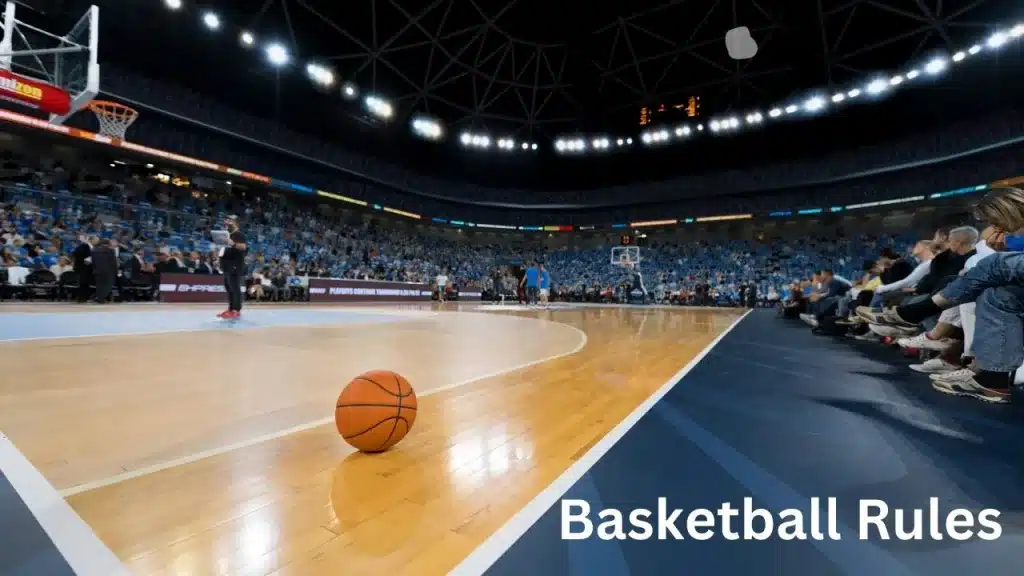
Mastering basketball isn’t just about skill—it’s about knowing the game inside and out. The basketball rules are crafted to ensure a fair, safe, and sportsmanlike environment, covering everything from player positions and ball specifications to game conduct and scoring methods.
Regulations extend beyond gameplay, addressing player, coach, and spectator conduct to foster respect and enjoyment for all. Dive into the essence of basketball, where understanding the rules and regulations is as crucial as the game itself.
Before you start, why not check your knowledge with our quick NBA rules quiz! Just click the “Start Quiz” button below:
What Are The 5 Main Rules And Regulations Of Basketball?
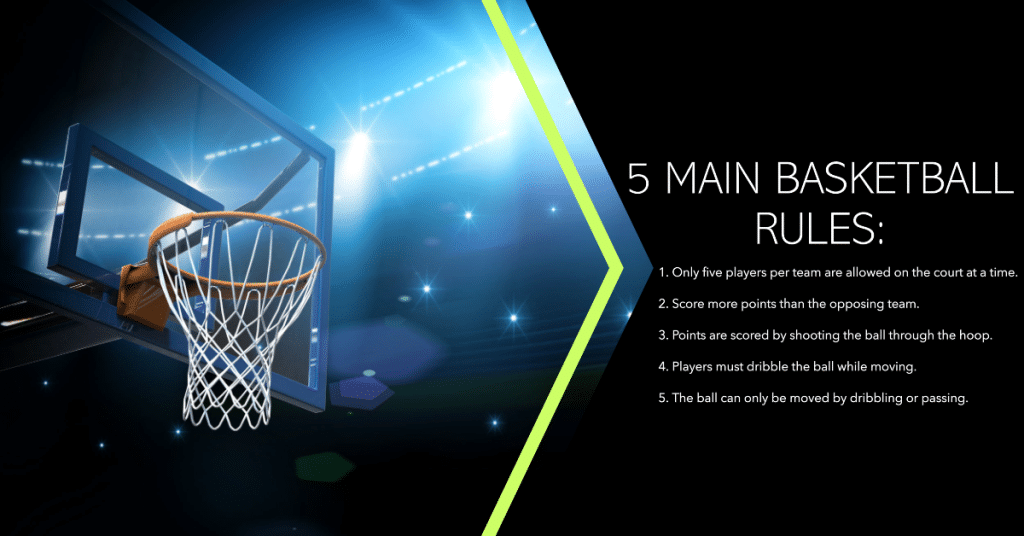
The five main rules of basketball are:
- Only five players per team are allowed on the court at a time.
- The game’s objective is to score more points than the opposing team.
- Points are scored by shooting the ball through the opposing team’s hoop.
- Players must dribble the ball while moving and can only take one turn at dribbling.
- The ball can only be moved by dribbling or passing.
Note that these are not the only rules of basketball but the five most fundamental ones.
Did you know? The original rules of basketball did not include dribbling. Players could only pass the ball to move it down the court.
What Is The Main Objective Of A Basketball Game?
The main objective of a basketball game is to score more points than the opposing team. Points are scored by shooting the ball through the opponent’s hoop. The team with the most points at the end of the game wins.
While basketball has other objectives, such as playing good defense and rebounding, the ultimate goal is to outscore the other team.
How Many Players Are On A Basketball Court During A Game?
In a traditional basketball game, five players are on the court for each team at any given time. However, the total number of players on a basketball team can vary depending on the league or organization.
For example, the NBA allows up to 12 players on a team, while FIBA, the international governing body for basketball, also allows 12 players.
How Long Is A Basketball Game?
The length of a basketball game can vary depending on the level of play and the league:
| League/Organization | Game Length |
|---|---|
| NBA | 4 quarters of 12 minutes each, totaling 48 minutes |
| WNBA | 2 halves of 20 minutes each, totaling 40 minutes |
| FIBA | 4 quarters of 10 minutes each, totaling 40 minutes |
| NCAA Men’s | 2 halves of 20 minutes each, totaling 40 minutes |
| NCAA Women’s | 4 quarters of 10 minutes each, totaling 40 minutes |
*Note that overtime periods can also extend the length of a basketball game. The actual duration of a game can vary depending on factors such as timeouts, fouls, referee reviews, number of quarters, and halftime breaks.
Did you know? Basketball games were originally played in two 15-minute halves with a five-minute rest between.
How Does A Basketball Game Start?
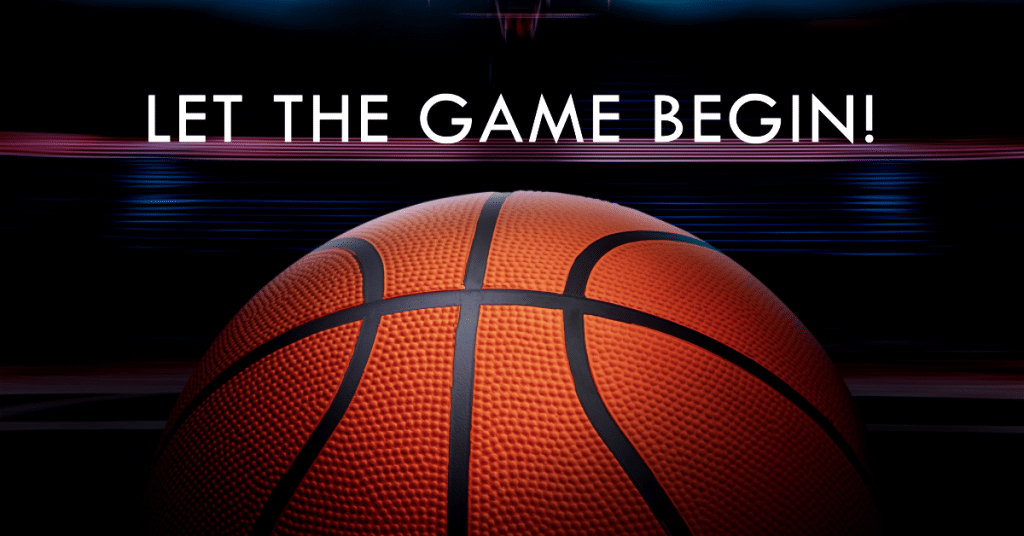
Every basketball game, whether professional or amateur, starts with a jump ball. During a jump ball, two players from opposing teams stand in the center circle of the court while the referee tosses the ball into the air.
The two players then try to tap the ball to their teammates to gain possession and start the game. The team that wins the jump ball gets possession of the ball first.
After the initial jump ball, possession of the ball alternates between the teams for the rest of the game, depending on which team scores or gains possession of a loose ball or rebound.
How Does A Foul Happen In Basketball?
A foul in basketball occurs when a player makes illegal contact or performs unsportsmanlike conduct against an opposing player during a play, whether intentional or unintentional.
Personal fouls are the most common type, resulting from personal contact between two opposing players. A personal foul committed by a team player in possession of the ball results in losing possession to the other team.
The fouled player is awarded one or more free throws, depending on the type of foul and the number of fouls committed by the opposing team. If a player commits too many fouls, he or she may be “fouled out” of the game and suspended from subsequent games.
Did you know? The rule allowing players to touch the ball with their hands only was introduced to prevent injury and make the game safer.
How Do Timeouts Work In Basketball?
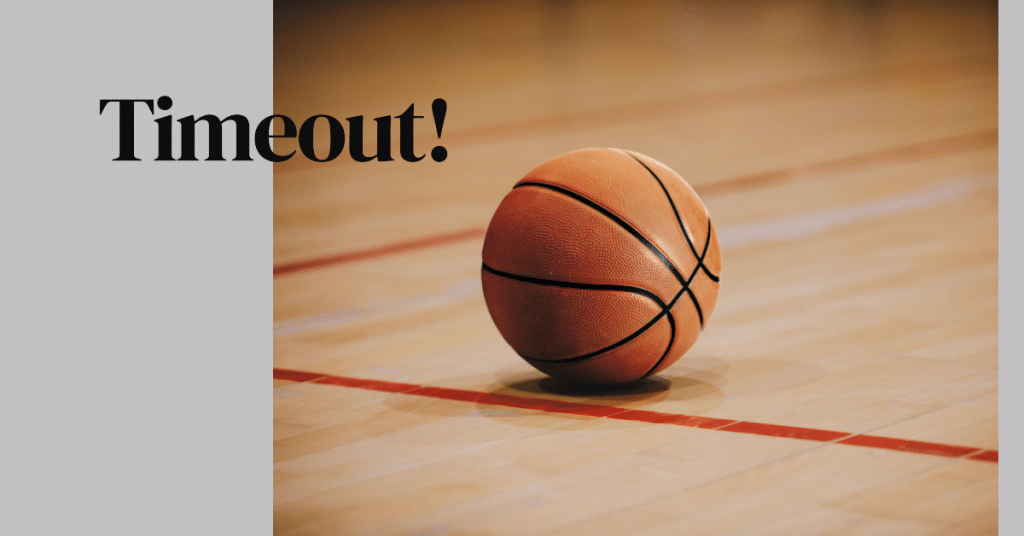
In basketball, timeouts are breaks in the game that allow teams to regroup, rest, and strategize. The number and length of timeouts can vary depending on the level of play and the league.
In the NBA, each team is allowed seven timeouts per game, lasting 75 seconds. In college basketball, each team is allowed four timeouts per game, three lasting 30 seconds and one lasting 60 seconds.
Teams can also call timeouts during overtime periods. During a timeout, players huddle with their coaches to discuss strategy, rest and make adjustments to their game plan.
More info on available here on the TOL process.
How Do Player Substitutions Work In Basketball?
In basketball, player substitutions occur when a player from the bench replaces a player on the court. Both teams have a bench of players who can be interchanged an unlimited number of times during the game.
To make a substitution, the player entering the game must report to the scorer’s table and give the official scorekeeper his or her jersey number.
The substitution can then be made during a dead ball situation, such as a timeout, a free throw, or a change of possession.
Substitutions can be made for many reasons, such as to give a player a rest, to change the team’s strategy, or to replace a player who has fouled out of the game.
How Are Points Scored In Basketball?

In basketball, points are scored when a player successfully shoots the ball through the hoop. A field goal made from within the three-point line is worth two points, while a field goal made from beyond the three-point line is worth three points.
Free throws, which is 15 feet from the center of the hoop, are worth one point each. The team with the most points at the end of the game is declared the winner. Points can be accumulated by making field goals or free throws.
The point system in basketball is designed to keep track of a game’s score and determine the winner.
Did you know? The three-point line was not always part of basketball; the NBA adopted it in 1979 to increase scoring and excitement.
What Happens If A Basketball Game Is Tied?
Basketball games generally cannot end in a tie. The game goes into overtime if the score is tied at the end of regulation time. In overtime, the teams play an additional five-minute period to determine the winner of the game.
If the score is still tied at the end of the first overtime period, additional overtime periods are played until a winner is determined. The team with the most points at the end of the overtime period is declared the winner of the game.
What Are the Regulation Basketball Court Dimensions?
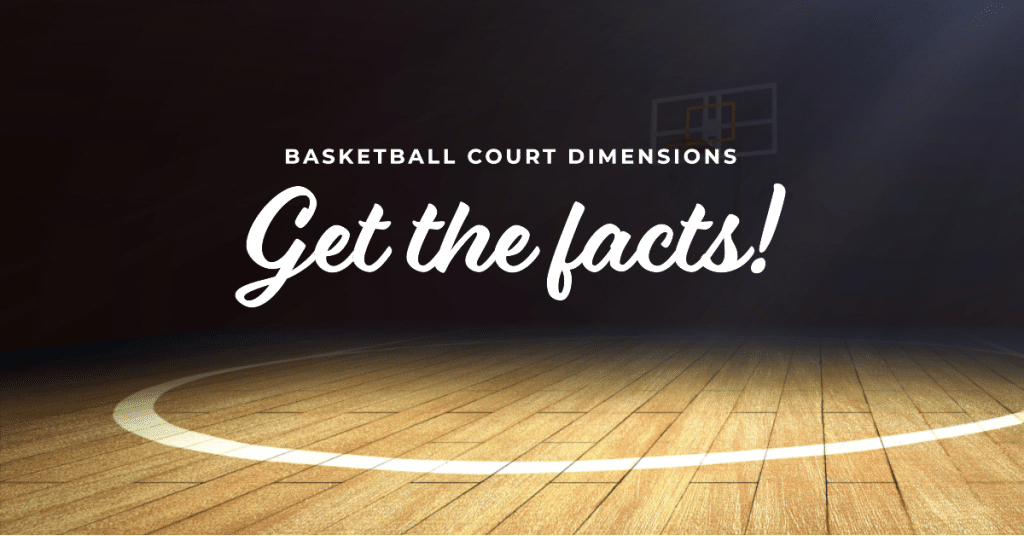
The regulation basketball court dimensions vary depending on the level of play, but a professional NBA court is typically 94 feet long by 50 feet wide. The court is divided into two halves, each measuring 47 feet by 50 feet.
The center circle has a radius of 6 feet and is located at the center of the court. The free-throw line is 15 feet from the backboard and 12 feet wide. The three-point line is 22 feet away from the basket at the corners and 23.75 feet from the basket at the top of the key.
The key, also known as the paint, is 16 feet wide and 12 feet long. The basketball hoop is located 10 feet above the ground and is attached to the backboard, which measures 6 feet by 3.5 feet.
Did you know? Basketball rules initially allowed the bottom of the net to be closed, requiring manual retrieval of the ball after each score.
What Are The Regulation Basketball Court Markings?
The regulation basketball court markings include the center circle, free-throw line, three-point line, and key. These markings determine the court’s boundaries and help players and officials make calls during the game.
What Are Basketball Violations?
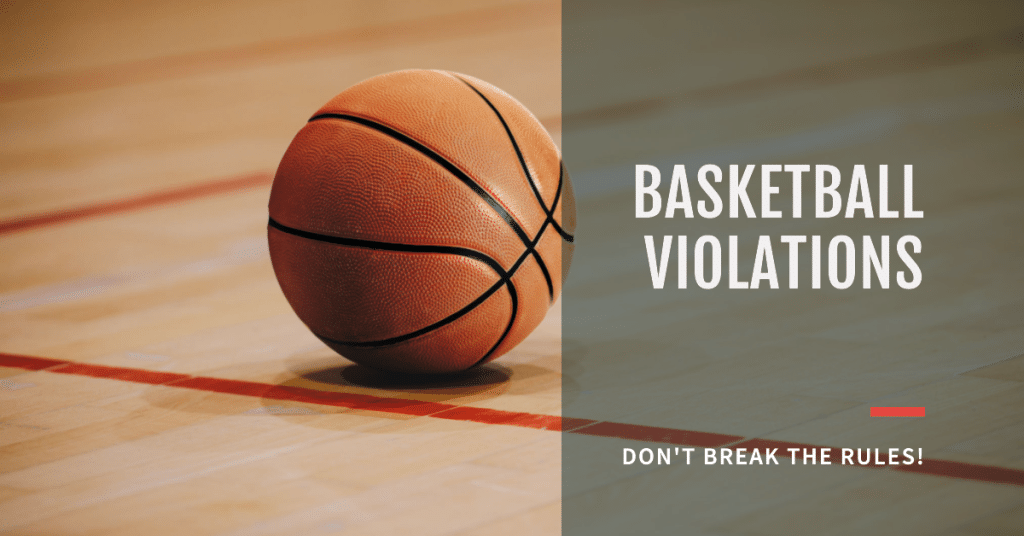
In basketball, violations are breaches of the basic rules of the game that result in the other team losing possession of the ball. Most violations are committed by the team with control of the ball, and they usually involve mishandling the ball or making an illegal move.
Common violations include traveling, double dribbling, carrying or palming, backcourt and shot clock violations. Violations can also occur when a player steps out of bounds or loses the ball out of bounds.
Violations differ from fouls, which involve contact between opponents or unsportsmanlike conduct and result in free throws, ball possession, or other penalties.
What Is Traveling In Basketball?
In basketball, traveling is a violation when a player takes too many steps without dribbling the ball. The usual rule of thumb is that players cannot take more than two steps with the ball in their hands before dribbling, passing, or shooting. A player taking more than two steps without dribbling is considered traveling.
The pivot foot is the foot that remains stationary while the other foot can move. If the pivot foot is lifted, a pass or try for a made basket must be made before the pivot foot is replaced to the floor.
Players in the NBA and FIBA are also given a “gather step” before taking two steps. The NCAA and NFHS do not allow two steps. Travel can also be called via carrying or an unestablished pivot foot. If a player’s pivot foot changes or moves, it is considered traveling.
What Is Double Dribble In Basketball?
In basketball, a double dribble is a violation that occurs when a player dribbles the ball with one hand, stops, and then dribbles the ball again with the same hand or touches the ball with both hands.
A double dribble can also occur when a player catches the ball and then dribbles it again without first passing or shooting it. Once a player has stopped dribbling, they cannot start another dribble unless another player from either team touches or gains control of the ball.
If a player commits a double dribble violation, the ball is turned over to the other team.
What Is Carrying or Palming the Ball In Basketball?
Carrying or palming the ball is a violation in basketball that occurs when a player holds the ball in one hand in a grip without allowing it to fall naturally or when the dribbling player continues to dribble after allowing the ball to come to rest in one or both hands and/or places their hand underneath the basketball.
Palming the ball is also known as turning the ball over. If a player palms the ball, it interrupts the dribble, and the player is called for a carrying violation. Palming the ball is illegal because it gives the player an unfair control advantage. If a player commits a carrying offense, the ball is turned over to the other team.
What Is Considered Out of Bounds In Basketball?
In basketball, players are considered out of bounds if they step on or cross the boundary lines with either foot or touch any object out of play. The boundary lines include the sidelines and the end lines.
If the ball goes out of bounds, it is considered out of play, and the team that did not touch the ball last is awarded possession of it.
The other team is awarded possession if the ball goes out of bounds off a player.
If the ball goes out of bounds off the rim or backboard, the team that did not touch the ball last is awarded possession.
If the ball goes out of bounds on a throw-in and is not touched by a player in the game, the ball is returned to the original throw-in spot.
What Is A 3-Second Violation In Basketball?
In basketball, a 3-second violation is a rule that prohibits an offensive player from spending more than three consecutive seconds in the key or paint area without attempting to score a basket.
The key or paint area is the rectangular area under the basket bounded by the end line, the free-throw line, and the two lane lines.
The purpose of the 3-second rule is to prevent offensive players from camping out in the key and clogging up the lane. If an offensive player violates the 3-second rule, the ball is turned over to the other team.
The 3-second rule applies only when the ball is in the front court and is not in effect during a jump ball, a throw-in, or a free throw.
What Is A 5-Second Violation In Basketball?
In basketball, a 5-second violation is a rule that helps promote continuous play and can occur in multiple situations. The most common situation is when a player holds the ball for five seconds and does not shoot, pass, or dribble the ball while being closely guarded by an opponent.
The five-second count starts when the defender is within six feet of the player with the ball. The rule prevents players from holding the ball for too long and encourages ball movement and scoring opportunities.
If a player violates the 5-second rule, the ball is turned over to the other team. A 5-second violation can also occur during a throw-in when a team attempting to throw the ball in-bounds has five seconds to release the ball towards the court.
What Is An 8-Second Violation In Basketball?
In basketball, an 8-second violation is a rule that prohibits the offensive team from failing to advance the ball past the half-court line within eight seconds after gaining possession of the ball in the backcourt.
The purpose of the 8-second rule is to prevent teams from camping with the ball on defense or playing keep-away from the opposing team.
If the offensive team fails to advance the ball past the half-court line within eight seconds, it is a violation, and possession is awarded to the opposing team. The 8-second rule applies only when the ball is in the backcourt and is not in effect during a jump ball, a throw-in, or a free throw.
What Is A 24-Second Violation In Basketball?
In basketball, a 24-second violation, also called a shot clock violation, occurs when a team fails to attempt a shot that hits the rim or goes in the basket before the shot clock runs out. The shot clock is a timer that limits a team has time to attempt a shot.
In the NBA, the shot clock is set to 24 seconds, while in college basketball, it is set to 30 seconds. The shot clock prevents teams from holding the ball for too long and encourages scoring opportunities.
If a team violates the shot clock, possession is awarded to the opposing team. The shot clock is reset to 14 seconds in the NBA if the offensive team gains possession of the ball after a missed shot that hits the rim and to 20 seconds in college basketball.
What Are Fouls Or Penalties In Basketball?

In basketball, a foul is an infraction of the rules more serious than a violation and results from personal contact with an opponent and unsportsmanlike behavior. There are multiple categories of fouls, including:
- personal fouls
- technical fouls
- flagrant fouls
Fouls can result in one or more penalties: loss of possession, free throws, fouling out of the game, and suspension from subsequent games.
What Are Personal Fouls In Basketball?
In basketball, a personal foul is a breach of the rules that concerns illegal personal contact with an opponent using any part of the body to impede their progress.
Personal fouls are the most common type in basketball, including charging, blocking, pushing, or holding. A player is allowed five personal fouls per game before fouling out and being disqualified from participation in the remainder of the game.
Personal fouls can result in one or more penalties: loss of possession, free throws, and disqualification from the game.
Personal fouls are penalized more severely if they involve excessive or violent contact, referred to as a flagrant foul or unsportsmanlike conduct.
What Are Technical Fouls In Basketball?
In basketball, a technical foul is a type of foul that does not involve physical contact with an opposing player and is usually assessed for unsportsmanlike conduct.
Technical fouls can be called on players, coaches, or other team personnel for various reasons, including arguing with officials, using profanity, taunting, or disrespecting opponents.
Technical fouls result in one or more penalties: loss of possession, free throws, and ejection from the game. In the NBA, each player, coach, or other team personnel is allowed two technical fouls before they are ejected from the game.
Technical fouls are the only type that do not result from explicit physical contact between opposing players during the game.
What Are Flagrant Fouls In Basketball?
In basketball, a flagrant foul is a personal foul that involves excessive or violent contact that could injure the fouled player. It may be unintentional or purposeful, and it is assessed to any player who makes unnecessary, unsportsmanlike, or excessive contact with another player.
The National Basketball Association (NBA) established the flagrant foul to deter contact that, in addition to being against the rules, puts an opponent’s safety or health at risk.
There are two flagrant fouls: Flagrant Foul Penalty 1, which is unnecessary contact committed by a player against an opponent, and Flagrant Foul Penalty 2, which is unnecessary and excessive contact committed by a player against an opponent.
When a flagrant foul is called, the fouled team is awarded free throws and possession of the ball. In the NBA, a player who commits a flagrant foul is subject to ejection from the game.
How Are Protests Handled In Basketball?
In basketball, protests against the outcome of a game based on an incorrect ruling or misapplication of the rules can be filed within 48 hours after the game’s conclusion.
The protest process has been in place since the league’s inception, and the NBA commissioner is the final authority on protests. The President of League Operations and his office handle the procedural work. The grounds for the protest must be stated in the notice, and the protesting team must provide evidence to support their claim.
The NBA commissioner has five days to decide after receiving the evidence. However, protests are rare in basketball, and teams often decide that filing a likely losing protest is not a good use of time and resources.
Protests against social or political issues, such as national anthem protests, are not handled through the protest process but are addressed through league policies and player activism.
What Are The Regulations Regarding Basketball Equipment?

In basketball, the regulations regarding equipment are designed to ensure player safety and prevent confusion among players. The referee is responsible for ensuring that no team member wears equipment or apparel that is dangerous or confusing to other players or officials.
Basketball
The International Basketball Federation (FIBA) and the National Collegiate Athletic Association (NCAA) specify the regulations for basketball in official games.
The official basketball must have a circumference of 29.5 inches (75 cm) and a weight of 22 ounces (623.7 grams) for men’s games and a circumference of 28.5 inches (72.4 cm) and a weight of 20 ounces (567 grams) for women’s games.
The ball must be made of leather or synthetic material and have a pebbled surface to provide a good grip. The ball must also be inflated to a pressure of 7.5 to 8.5 pounds per square inch (psi) and be checked by the officials before the game to ensure that it meets the regulations.
The regulations also specify the ball’s color, which must be orange for FIBA-sanctioned games and brown for NCAA games. If the ball becomes damaged or deflated during the game, it must be replaced.
Shoes
In basketball, the regulations for shoes in official games are designed to ensure player safety and prevent damage to the court. The only footwear permitted on the court is soft, dry, clean rubber-soled sneakers. Black-soled shoes are not allowed unless they are basketball shoes with a black sole.
The NBA allows players to wear basketball footwear manufactured by the shoe company of their choice during games, but the league has rules on the color and design of the shoes. The NBA has fined players for wearing shoes that violate the league’s rules on color and design.
The NCAA also has rules on the color and design of shoes, but they are less strict than the NBA’s rules. The NCAA’s rules aim to allow players to be comfortable and express their individuality while maintaining a professional appearance.
If a player wears shoes that do not comply with the rules, there is no penalty, but the player may be asked to change his or her shoes before the game.
Uniforms
In basketball, the regulations for uniforms in official games are designed to ensure that players are easily identifiable and to maintain a professional appearance.
The National Federation of State High School Associations (NFHS) and the National Collegiate Athletic Association (NCAA) have specific rules on the design and color of basketball uniforms. Players must wear both game pants and a game jersey, and the uniform jerseys must comply with all rules listed in the regulations.
The undershirt has the most color restrictions. It must be solid white, black, beige, or the predominant color of the jersey.
The NBA also has rules on the design and color of basketball uniforms, and players must keep their basketball jerseys tucked into their shorts while playing.
Wearing t-shirts underneath the jerseys is not allowed.
The uniform regulations ensure that players are easily identifiable and maintain a professional appearance on the court.
If a player wears a uniform that does not comply with the rules, there is no penalty, but the player may be asked to change his or her uniform before the game.
Protective Gear
In basketball, the regulations for protective gear in official games are designed to prevent injuries and ensure player safety. Protective equipment may be worn by any player at all times, but it must be worn properly. Padding must cover splints, braces, and other protective gear.
The most common protective gear worn in basketball is a mouthguard, which prevents broken teeth and injuries to the mouth and tongue.
Protective eyewear is also recommended for players who wear glasses or have a history of eye injuries. Basketball players should also wear supportive and well-fitting sneakers, an athletic supporter (for males), and a supportive sports bra (for females).
The regulations for protective gear may vary depending on the age group and level of play. At the collegiate level, basketball uniforms are far more regulated, and players must wear both game pants and a game jersey.
Jewelry
In basketball, the regulations for jewelry in official games are designed to prevent injuries and ensure player safety. Jewelry, including necklaces, earrings, bracelets, and watches, is not allowed to be worn during games.
The National Federation of State High School Associations (NFHS) and the National Collegiate Athletic Association (NCAA) have specific rules regarding the wearing of jewelry during games.
Religious and medical-alert medals are not considered jewelry and can be worn.
The regulations for jewelry may vary depending on the age group and level of play. The rules are in place to protect players from injury and to help prevent damage to basketball court floors.
How Have Basketball Rules Evolved?

Basketball rules have evolved to improve the game’s safety, fairness, and entertainment value. Major rule changes over the years have addressed the number of players, court boundaries, dribbling, and eliminating the center jump after making baskets.
- The duration of games has also changed from two fifteen-minute halves to two 20-minute halves of playing time.
- The introduction of the 24-second clock in 1954 was a significant rule change that revolutionized the game’s pace and scoring.
- The widening of the lane from 6 feet to 12 feet in 1951 and the introduction of the three-point line in 1979 were also significant rule changes that have had a lasting impact on the game.
- The rules have also adapted to advances in technology, such as the use of instant replay to review calls and the introduction of the coach’s challenge.
The evolution of basketball rules has made the game safer, more exciting, and more accessible to players and fans.
Can A Basketball Player Be Kicked Out Of A Game?
Yes, a basketball player can be kicked out of a game for violating the rules.
In NCAA basketball, an official may disqualify a player from participating in the remainder of the game for committing a flagrant foul or receiving two technical fouls.
In high school basketball, an ejection is automatic after a player receives two technical fouls.
In basketball, an ejection removes a player from the game due to a direct violation of a sports rule. Any player can be ejected for violent fouls, unsportsmanlike conduct, fighting, and committing two technical fouls. The decision for such a penalty is at the discretion of the officials.
Ejected players must leave the court area for the remainder of play, and must do so immediately, or else risk even heavier fines/suspensions.
The rules for ejection may vary depending on the level of play and the governing body.
What Are Some Of The Main Differences In Rules Between Basketball Leagues?
Basketball is a globally popular sport played under different rules and regulations depending on the league or organization governing it. Some of the main differences in rules between the different basketball leagues include:
| Category | NBA | FIBA | High School | NCAA |
|---|---|---|---|---|
| Court Size | 94 ft x 50 ft | 91.9 ft x 49.2 ft | 84 ft x 50 ft | 94 ft x 50 ft |
| Game Duration | 48 minutes | 40 minutes | 32 minutes | 40 minutes (2 x 20 min halves) |
| Shot Clock | 24 seconds | 14 seconds | No shot clock | 30 seconds |
| Foul Limits | 6 fouls | 5 fouls | 5 fouls | 5 fouls |
| Three-Point Line | 23.75 ft | 22.15 ft | 19.75 ft | 22.15 ft |
| Overtime Duration | 5 minutes | 5 minutes | 4 minutes | 5 minutes |
| Team Fouls before Bonus | 5 fouls (per quarter) | 4 fouls (per quarter) | 7 fouls (per half) | 7 fouls (per half) |
| Personal Fouls for Disqual. | 6 fouls | 5 fouls | 5 fouls | 5 fouls |
| Jump Ball/Alternating Poss. | Jump Ball | Alternating Possession | Alternating Possession | Alternating Possession |
| Technical Foul Penalty | 1 free throw | 1 free throw | 2 free throws | 2 free throws |
This table summarizes the differences in court size, game duration, shot clock, foul limits, and three-point line distance among the NBA, NCAA, FIBA, and high school basketball leagues.
Basketball Rules and Regulations Conclusion
In conclusion, basketball is a game that is governed by a set of rules and regulations that are designed to ensure fair play and safety for all players. These rules cover everything from the size of the court to the number of players on each team, and from the game’s length to the types of fouls that can be committed.
Some of the most important basketball rules and regulations include:
- The court must be a certain size, with specific markings and boundaries.
- Each team must always have a certain number of players on the court.
- The game is divided into quarters, with a halftime break.
- Players are not allowed to carry or travel with the ball.
- Fouls can result in free throws or even ejections from the game.
It is important for players, coaches, and fans to understand these rules and regulations to appreciate the game of basketball fully. Following these guidelines, players can compete at their highest level while maintaining a safe and fair playing environment.

